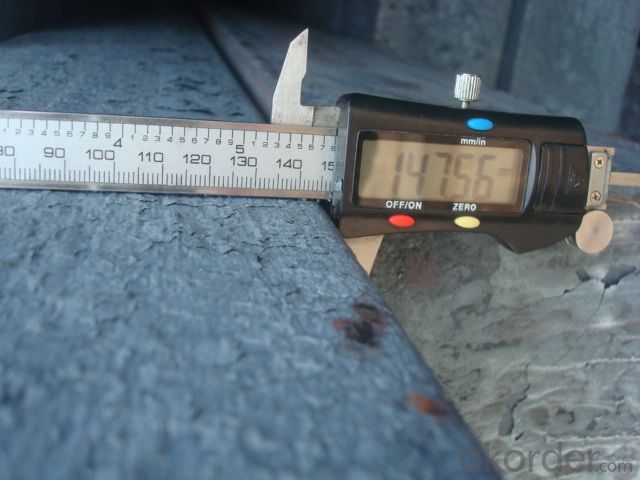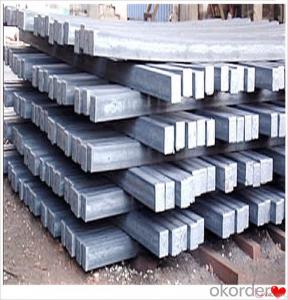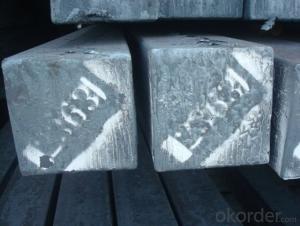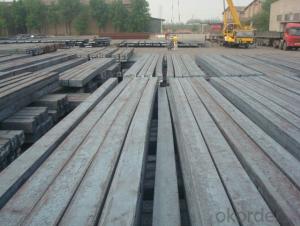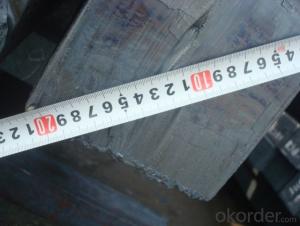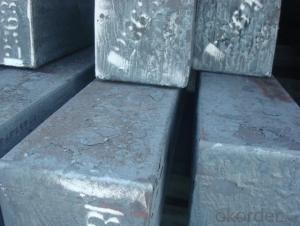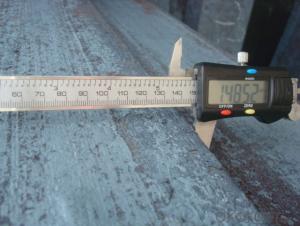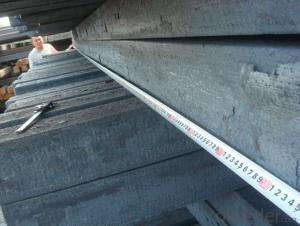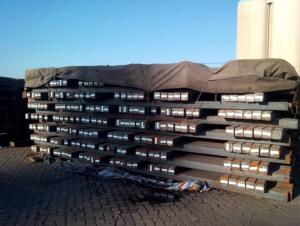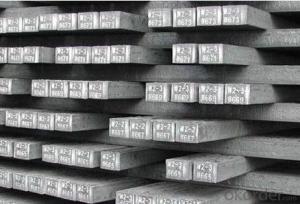Continue Casting Steel Billet Manufactured By Blasting Furnace
- Loading Port:
- Qingdao
- Payment Terms:
- TT OR LC
- Min Order Qty:
- 1000 m.t.
- Supply Capability:
- 10000 m.t./month
OKorder Service Pledge
OKorder Financial Service
You Might Also Like
Continue Casting Steel Billet Manufactured By Blasting Furnace
1.Structure of Continue Casting Steel Billet Manufactured By Blasting Furnace
Continue Casting Steel Billet Manufactured By Blasting Furnace is the raw material of all kinds of steel mill. Billet section of square, round, flat, rectangular and abnormity, etc Several, mainly related to shape of rolled products. Simple rolled section steel, choose cross section of square billet or rectangular billet. rolling The sector products such as flat steel, Angle steel, select the rectangular billet or slab. Had better profiled billet when production beams, channels, and in rolling process Lines and improve the yield. The raw material of round billet is the production of seamless tube.
2.Main Features of Continue Casting Steel Billet Manufactured By Blasting Furnace.
Continue Casting Steel Billet Manufactured By Blasting Furnace section size should meet the requirements of rolling deformation and finished product quality, but also roll strength and biting condition of restrictions. General steel Billet section height H. And the roll diameter D The ratio of the ( namely H/D) Should be less than or equal to zero 0.5 . Length of steel billet by finishing temperature, Rolling time and the length of the product Or times ruler. When heated too long accident prone to bump the furnace wall of steel, too short, furnace bottom utilization rate is not high, influence the heating furnace production. For the production Choose a variety of steel and steel billet, should consider the affinities of billet, as far as possible in order to improve the productivity of the roughing mill, simplify the stock management of workshop.
3. Continue Casting Steel Billet Manufactured By Blasting Furnace Images
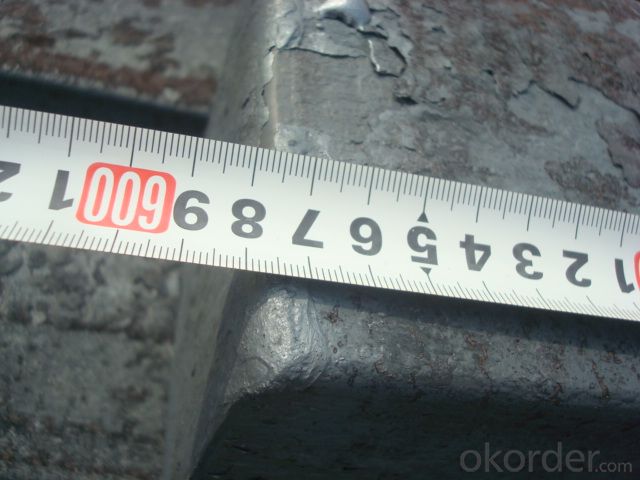
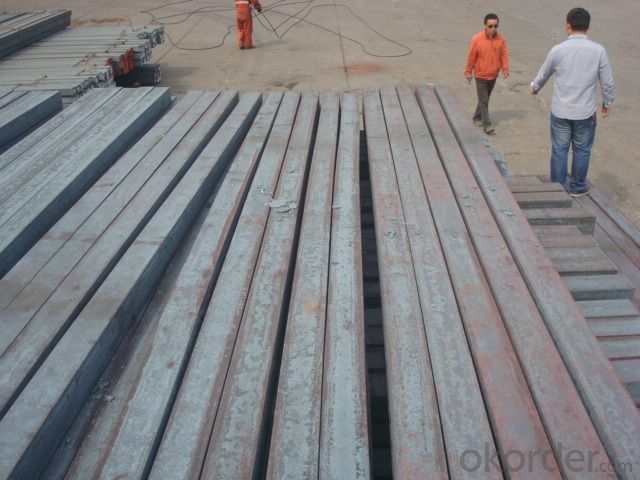
4. Continue Casting Steel Billet Manufactured By Blasting Furnace Specification
Continue Casting Steel Billet Manufactured By Blasting Furnace rolled steel, after processing can be used for mechanical parts, forging parts, processing all kinds of steel, steel Q345B channel steel, wire rod is the role of the billet. Steel billet is used in the production of semi-finished products, generally cannot be used directly for the society. Steel billets and steel are strictly divided into standard, cannot decide to whether the business enterprise of the final product, and according to unified standards to perform the whole society. Typically, billet and the steel is relatively easy to distinguish, but for some steel billet, and have the same specification and same steel purposes (such as rolling tube billet), whether can be used for other industries, whether through steel processing process, whether through a finished product rolling mill processing to distinguish
Material standard The editor Range of thickness: 150-240 - mm + / - 5 mm width range: 880-1530 - mm + / - 20 mm Length: 3700-10000 - mm + / - 500 - mm Cross-sectional size: 64 * 64; 82 * 82; 98 * 98; 124 * 124; 120 * 150; 152 * 164; 152 * 170 mm Length: 9000 mm Section of tolerance: billet: 1.0 + / - 2.0-1.0 + / - 1.0 mm slab: width: + / - 2.0 mm thickness: + / - 3.0 mm The length tolerance: + / - 200 mm Section diagonal tolerance: 3.5-8.0 MM Billet section size protrusions requirements: < 1242 mm, do not allow; > = 1242 mm, < = 2 mm 1242 mm, < = 3 mm Beheading (shear) extension deformation: < 1242 mm billet: no control; The slab: < = 15 mm Surface tilt: no more than billet section 0.1 Bending: every 1 m length is not more than 10 mm The distortion: length < = 5 m, < = 11. ; The length of the < = 7.5 M, < = 5. Material % 3 sp/PS chemical composition: C Mn Si S P
There are three shapes of the steel billets: square billet, slab, rectangular billet The Chinese billet, rectangular billet is mainly suitable for rolling hot rolled strip, building reinforced bar, Ordinary wire, high speed wire rod and various small profile. Of the slab are mainly used for rolling plate and hot coil sheet.
5.FAQ of Continue Casting Steel Billet Manufactured By Blasting Furnace
We have organized several common questions for our clients,may help you sincerely:
①How about your company?
A world class manufacturer & supplier of castings forging in carbon steel and alloy steel,is one of the large-scale professional investment casting production bases in China,consisting of both casting foundry forging and machining factory. Annually more than 8000 tons Precision casting and forging parts are exported to markets in Europe,America and Japan. OEM casting and forging service available according to customer’s requirements.
②How to guarantee the quality of the products?
We have established the international advanced quality management system,every link from raw material to final product we have strict quality test;We resolutely put an end to unqualified products flowing into the market. At the same time, we will provide necessary follow-up service assurance.
③How is the packaging and delivery?
Loose by Vessel and the delivery term is based on the the quantity and our factory’s schedule then.
- Q: How are steel billets used in the production of marine components?
- Steel billets are used in the production of marine components as they serve as the raw material from which various marine parts are manufactured. These billets are heated, shaped, and machined to create components like ship hulls, propeller shafts, engine parts, and other structural elements. By using steel billets, marine manufacturers can ensure the strength, durability, and corrosion resistance required for reliable performance in the demanding marine environment.
- Q: What are the main advantages of using steel billets in manufacturing?
- The main advantages of using steel billets in manufacturing include their high strength and durability, versatility in shaping and molding, excellent heat and corrosion resistance, and cost-effectiveness. Steel billets provide a reliable and consistent material for various applications, ensuring structural integrity and longevity in the manufactured products. Additionally, their malleability allows for easy customization and adaptation to different manufacturing processes, making steel billets a preferred choice for many industries.
- Q: Charcoal classification
- Hard charcoal. By hardwood such as Fagaceae Quercus, Castanopsis trees, secondary birch and etc..Broad-leaved charcoal. Charcoal made from a mixture of hard and soft hardwood.Pine charcoal. Carbon fired from pine or other needle wood. In addition to bamboo and bamboo charcoal burning with shells, stones (coconut shell, peach stone charcoal etc.) wood raw material firing. Charcoal collected from household stoves in the cell known as carbon. If the charcoal is crushed and mixed with proper adhesive, and then pressed, formed and roasted, the deposit is made. According to the burning process of silica and carbon black.
- Q: How do steel billets contribute to the overall weight reduction of a structure?
- There are several ways in which steel billets contribute to reducing the overall weight of a structure. Firstly, through a process called continuous casting, steel billets can be precisely shaped and sized, resulting in lighter and more compact billets. This, in turn, decreases the weight of the structure. Secondly, advanced alloys and compositions can be used to make steel billets with high strength-to-weight ratios. These alloys are specifically designed to provide the same level of strength and durability as traditional steel, but with a lower weight. By incorporating these lightweight steel billets into the construction of a structure, the overall weight can be significantly reduced without sacrificing strength and performance. In addition, steel billets can be employed in the manufacturing of complex shapes and structures using techniques such as extrusion and forging. These methods allow for the creation of intricate designs and structures, eliminating the need for additional components and reducing the overall weight of the structure. Furthermore, steel billets can be used in the construction of lightweight structural elements such as beams, columns, and trusses. These elements can be designed to have hollow sections or thinner profiles, which reduces the amount of steel needed while still maintaining structural integrity. This results in a substantial decrease in the overall weight of the structure. In conclusion, steel billets contribute to weight reduction in structures by enabling the production of lighter and more compact components, utilizing advanced alloys with high strength-to-weight ratios, allowing for the creation of complex shapes and structures, and facilitating the construction of lightweight structural elements.
- Q: What are the main factors affecting the formability of stainless steel billets?
- The main factors affecting the formability of stainless steel billets include the composition of the steel, the temperature at which it is being formed, the grain size and structure of the material, and the amount of deformation applied during the forming process. Firstly, the composition of the stainless steel billet plays a crucial role in its formability. Different grades of stainless steel have varying amounts of alloying elements such as chromium, nickel, and molybdenum, which affect the material's mechanical properties. For example, higher levels of chromium can increase the material's resistance to corrosion but may reduce its formability. Therefore, the choice of stainless steel grade is essential to ensure optimal formability for a specific application. Secondly, the temperature at which the stainless steel billet is being formed influences its formability. Stainless steel exhibits better formability at elevated temperatures due to increased ductility. Heating the billet helps to reduce its yield strength and allows for easier deformation. However, excessive heating can lead to grain growth and reduced mechanical properties, so it is crucial to find the right balance between temperature and formability. The grain size and structure of the stainless steel billet also affect its formability. Fine-grained materials tend to exhibit better formability compared to coarse-grained ones. Finer grains allow for more uniform deformation and reduced likelihood of cracking or tearing during forming processes. Additionally, the presence of certain microstructural features, such as precipitates or twins, can also impact the formability of stainless steel billets. Lastly, the amount of deformation applied to the stainless steel billet during the forming process affects its formability. Excessive deformation can lead to strain hardening, causing the material to become less ductile and more prone to cracking. Therefore, it is essential to carefully control the amount and distribution of deformation to ensure optimal formability. In summary, the main factors affecting the formability of stainless steel billets include the composition of the steel, the temperature at which it is being formed, the grain size and structure of the material, and the amount of deformation applied during the forming process. Understanding and controlling these factors is crucial for achieving the desired formability and ensuring successful manufacturing of stainless steel components.
- Q: How are steel billets used in the manufacturing of valves and pumps?
- Steel billets are used in the manufacturing of valves and pumps as the raw material for shaping and forming the critical components of these mechanical devices. These billets are heated, forged, and machined to create the necessary shapes and sizes required for valves and pumps. The resulting components, such as valve bodies, stems, and pump casings, exhibit high strength, durability, and resistance to corrosion, making them suitable for withstanding the demanding conditions of fluid control and transportation in various industries.
- Q: What are the specifications for steel billets used in the aerospace industry?
- The aerospace industry demands highly precise and stringent specifications for steel billets. These billets must adhere to specific standards to guarantee the safety and durability of aircraft components. Firstly, the steel utilized for aerospace billets must possess outstanding strength and toughness. It must exhibit a high tensile strength and the ability to withstand extreme forces and stresses encountered during flight. Additionally, the steel must demonstrate excellent fracture resistance to minimize the risk of catastrophic failure. Moreover, the steel billets must possess exceptional resistance to corrosion and oxidation. This is crucial as aircraft frequently operate in harsh environments, such as high altitudes and exposure to various chemicals. The steel should resist rust, pitting, and other forms of degradation that can compromise its structural integrity over time. Furthermore, the steel billets employed in aerospace applications must exhibit precise dimensional tolerances and uniformity. They should be manufactured according to exact specifications to ensure consistency in the production of aircraft components. This entails precise size, shape, and surface finish, which are vital for proper fitting and assembly. Regarding chemical composition, the steel used for aerospace billets may vary depending on the specific application and component being manufactured. However, it typically includes elements like carbon, manganese, chromium, nickel, and molybdenum. These alloying elements enhance the mechanical properties of the steel, such as hardness, toughness, and heat resistance. Additionally, the steel billets utilized in the aerospace industry undergo rigorous testing and quality control procedures. This includes non-destructive testing methods such as ultrasonic inspection, magnetic particle inspection, and dye penetrant inspection to identify any internal defects or discontinuities. In summary, the specifications for steel billets used in the aerospace industry encompass exceptional strength, toughness, corrosion resistance, dimensional accuracy, and precise chemical composition. These stringent requirements ensure the reliability and safety of aircraft components, enabling them to withstand the demanding conditions experienced during flight.
- Q: Can the production of continuous casting billet be damaged by using intermediate frequency electric furnace?
- If there are no other major facts of harm, it seems that there is no such mandatory legal provisions to bear criminal responsibility. Mandatory closing and fines at most.
- Q: What are the different types of surface coating methods used for steel billets?
- Steel billets commonly undergo various surface coating methods to improve their durability, corrosion resistance, and overall performance. Some frequently utilized techniques for coating steel billets include: 1. Hot-dip galvanizing: Immersing the steel billets in molten zinc forms a protective layer, ensuring excellent durability and preventing corrosion. 2. Electroplating: Electrochemically depositing a thin layer of metals like zinc, nickel, or chromium onto the surface of the steel billets enhances corrosion resistance and improves aesthetics. 3. Powder coating: Applying a dry powder onto the steel billets' surface and subsequently heating it creates a protective layer. This method offers exceptional durability, chemical resistance, and a wide range of color options. 4. Paint coating: A liquid paint is applied to the steel billets, forming a protective layer that provides corrosion resistance. This technique allows for customization with different colors and finishes. 5. Thermal spray coating: A thermal spray gun is used to spray molten or powdered metals onto the steel billets' surface. This coating provides outstanding wear resistance, corrosion protection, and can be customized with various materials. 6. Anodizing: While primarily used for aluminum billets, anodizing can also be applied to steel. This electrochemical process creates an oxide layer on the steel billets' surface, enhancing corrosion resistance and providing a decorative finish. Each of these coating methods has its own set of advantages and disadvantages, and the selection depends on factors such as the desired protection level, aesthetics, and specific requirements of the steel billets.
- Q: How do steel billets contribute to the overall vibration resistance of a structure?
- Steel billets, due to their specific characteristics, significantly contribute to the overall vibration resistance of a structure. First and foremost, steel is a very dense and rigid material, which means that it possesses a high natural frequency. This high natural frequency allows steel billets to absorb and dissipate the energy generated by external vibrations more effectively than other materials. Moreover, steel billets have excellent damping properties. Damping refers to the ability of a material to reduce the amplitude of vibrations over time. Steel billets, being highly dense and rigid, are able to absorb and dissipate vibrations quickly, preventing them from propagating throughout the structure. This helps in reducing the overall vibration levels and, subsequently, increasing the overall vibration resistance of the structure. Furthermore, steel billets possess high tensile strength and stiffness, which allow them to resist deformation under dynamic loads. This means that when subjected to vibration forces, steel billets are able to maintain their shape and structural integrity, minimizing the risk of failure or damage. The high tensile strength of steel also enables it to withstand the impact of external forces without undergoing significant deformation or permanent damage. In addition, steel billets can be designed and manufactured to specific dimensions and shapes, allowing for precise integration into various structural components. This ensures that the steel billets are optimally positioned within the structure, enhancing their vibration resistance capabilities. Overall, steel billets contribute to the overall vibration resistance of a structure by effectively absorbing and dissipating vibrations, resisting deformation, and maintaining their structural integrity. Through these properties, steel billets help to minimize the impact of external vibrations and ensure the longevity and stability of the structure.
Send your message to us
Continue Casting Steel Billet Manufactured By Blasting Furnace
- Loading Port:
- Qingdao
- Payment Terms:
- TT OR LC
- Min Order Qty:
- 1000 m.t.
- Supply Capability:
- 10000 m.t./month
OKorder Service Pledge
OKorder Financial Service
Similar products
Hot products
Hot Searches
Related keywords


